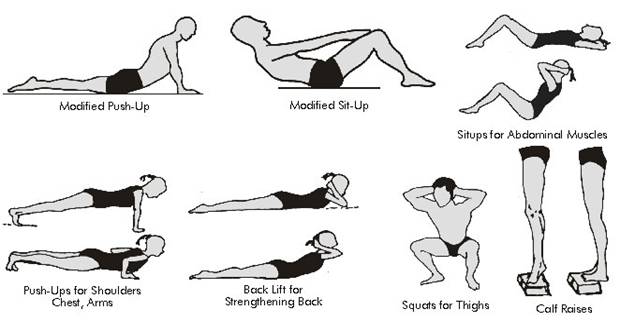Complete Health Guide
| STANDARD YOGASANAS | |||||||||||||||||||||||
| 1 . Stand warm up for Pawan Muktasana series. 2. Suryanamaskar (Sun Salutation) Effect - on full body including heart and circulation. 3. Ardh-halasana (30, 60, 90 degrees, double leg raises) Effect - on abdomen, legs, back reproductive organs. 4. Sarbangasana (Shoulder stand) Effect - on brain, nervous system, thyroid, circulation. 5. Halasana (Plough pose) Effect - on spine, nervous system, back, lungs. 6. Matsyasana (Fish pose) Effect - on chest, neck, thyroid, lungs. 7. Bhujangasana (Cobra pose) Effect - on lower back, reproductive organs, lungs, spine, chest, abdominal organs. 8. Salabhasana, (Locust pose) Effect - an buttocks, legs, hips, constipation, gas, digestion, etc. 9. Dhanurasana (Bow pose) Effect - on abdomen, digestion, legs, back. 10. Naukasana (Boat pose) (V sit-ups) Effect - on spine, abdomen, chest, etc. 11. Bakrasana (Half spinal twist) Effect - on spine, fat on waist, gas, digestive organs. 12. Paschmottasana (Sitting toe touch) or Padahasatasana (Standing toe touch) Effect - on digestion, spine, legs. 13. Trikonasana (Triangle) Effect - on spinal nerves, waist, digestion. 14. Pranayama (Deep breathing) 10 rounds each. a) Anulome / Vilome - alternate nostril breathing, and b) Kapalbhatti.. - belly breathing Effect - on lungs and respiratory system. 15. Shavasana (Corpse pose) - as often as required. Effect - on physical / mental relaxation. | |||||||||||||||||||||||
YOGASANAS  | |||||||||||||||||||||||
GYM EXERCISES / WEIGHT TRAINING | |||||||||||||||||||||||
Weight training is basically for strengthening and building up the muscles. An all-round programme must have some stretching and cardio-vascular exercises as well. In addition, weight training loads the bones thereby strengthening and protecting against osteoporosis. The points to keep in mind in weight training are as follows:
| |||||||||||||||||||||||
 | |||||||||||||||||||||||
| Nutrition and Calorie Management: Generally speaking, our daily food intake must comprise a balanced diet of 1500-2000k calories with fibre (above 75 gm) and low fat (below 30 gm). Consult your nutritionist for specific advice. | |||||||||||||||||||||||
 | |||||||||||||||||||||||
 | |||||||||||||||||||||||
 | |||||||||||||||||||||||
 | |||||||||||||||||||||||
 | |||||||||||||||||||||||
| Micro - Nutrients: | |||||||||||||||||||||||
| The guide to healthy eating pyramid provides you a balanced diet, with ample vitamins, minerals and anti-oxidants. The therapeutic benefit of these micro-nutrients are explained below.. | |||||||||||||||||||||||
  | |||||||||||||||||||||||
STRESS MANAGEMENT | |||||||||||||||||||||||
| Stress has existed from the time of Early Man but has now become an omnipresent phenomenon in the life of 'Modern Man'. It has pervaded all layers of life. Stress is the bio-psycho-social response of the body to a demand, mental or physical. Stress is an arousal response the body makes, when a situation is perceived as being stressful. The impact of this arousal affects emotional as well as cognitive thinking. The impact is seen in behavioral and physiological change.. When stress is long term and chronic it leads to chronic psychosomatic ailments. While there is an undeniable link between stress and illness, optimal stress is a prerequisite for success in every task. Stress is the wind beneath your wings pushing you towards achievement. If stress can trigger off psychosomatic ailments in those living in the fast track, it can be a trigger even to those who suffer from monotony, boredom or frustration. It is therefore very essential to bring a balance between too much and too little stress. The first step in managing stress is to develop a stress-free personality. A high self-esteem, assertive behavior and a positive attitude help in building a stress-free perception. It also helps to focus on areas where control and change are possible. Locate the source of stress and use a problem solving approach to deal with it step by step. All stress you can understand. Some you can change. Some you may have little control over. You may then need to change your attitude and response towards these stressors. Thereby reducing stress. Any exercise programme done regularly utilizes the body's stress hormones. Exercise not only makes the body fit, but also acclimatizes the heart and lungs to increased activity, as in stressful situations. Relaxation and meditation techniques result in calming brain waves, and reducing the effects of stress. This is especially effective with stressrelated ailments such as Hypertension, Headaches, Digestive ailments, Cardiac ailments, Sleep problems to name just a few. Stress may be an irritant in your life or it may be a factor of passive existence. Change of perspective will help change this stress to an active, rewarding life. One of the best gifts of nature is sleep. Daily sleep of 6 - 8 hours helps in relaxation and repair of the body and mind. It provides sufficient time for deep - NREM and dream REM sleep restoring physical and mental health. Stress may be an irritant in your life or it may be a factor of passive existence. Change of perspective will help change this stress to an active, rewarding life. One of the best gifts of nature is sleep. Daily sleep of 6 to 8 hours helps in relaxation and repair of the body and mind. It provides sufficient time for deep - NREM and dream REM sleep restoring physical and mental health. | |||||||||||||||||||||||
| Use some of these stress defense mechanisms & optimize your stress. | |||||||||||||||||||||||
| |||||||||||||||||||||||
| Plan your time well. You only have 24 /hours a day and many important areas to fit in. A simple formula for time & stress management. You could personalize it to suit your needs. Remember you can't delete any activity or reduce time for health factors. | |||||||||||||||||||||||
| |||||||||||||||||||||||
| EAR, NOSE, THROAT, TEETH, EYE CARE | |||||||||||||||||||||||
I. Ears
| |||||||||||||||||||||||
II. Nose
| |||||||||||||||||||||||
III. Throat
| |||||||||||||||||||||||
Ensure Safety & B Eco Friendly



Comments
Post a Comment